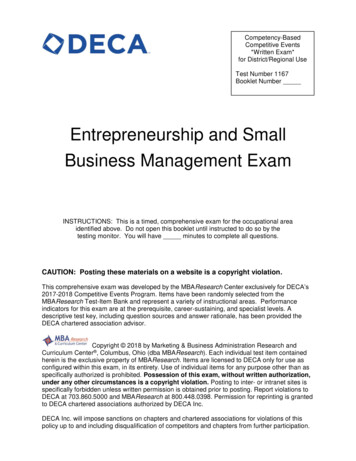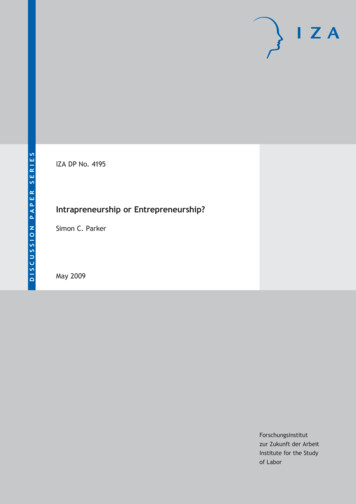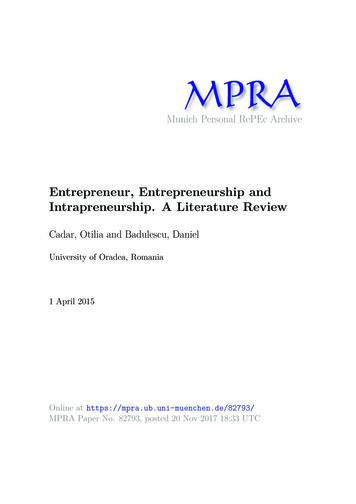
Transcription
Entrepreneurship Education as a StrategicApproach to Economic Growth in KenyaRobert E. NelsonUniversity of Illinois at Urbana-ChampaignScott D. JohnsonUniversity of Illinois at Urbana-ChampaignFor the past 10 years, small enterprise development has beenidentified as a priority area in development policy in general, and inAfrica in particular. There is now considerable experience amonginternational donor agencies with interventions aimed at the development of the small enterprise sector. Increasingly, small enterprisedevelopment is regarded as crucial to the achievement of broaderobjectives such as poverty alleviation, economic development, andthe emergence of more democratic and pluralistic societies. Thetrend in recent years has been to target a greater proportion ofinternational aid resources to small enterprise development (Working Group on Business Development Services, 1997).International donor agencies such as the World Bank, UnitedNations Development Program, and the African Development Bankhave identified the small enterprise sector as a key to developmentin African countries and have financed a number of projects toencourage the section to grow. In addition, Sweden (SIDA), Germany (GTZ), Great Britain (ODA), and the United States (USAID)are supporting small enterprise development in African countriesthrough their international aid programs. For example, the ODA'sfinancial support of small enterprise development has increased inAfrica from approximately .5 million in 1992-93 to 16.2 million in1996-97. Within the United Nations system, the International LaborOrganization (ILO) and the United Nations Industrial DevelopmentNelson is Associate Professor and Coordinator of International Programs and Johnson is Associate Professor and Graduate Programs Coordinator. Both authors are in the Department of Human Resource Education,University of Illinois at Urbana-Champaign, Champaign, Illinois.Volume 35Number 171997
8JOURNAL OF INDUSTRIAL TEACHER EDUCATIONOrganization (UNIDO) have implemented a variety of programs tosupport small enterprise development, especially for Africa.In Kenya, a variety of policies and programs have been enactedto facilitate the growth of the small enterprise sector. The smallenterprise sector in Kenya is defined as being all of those businessesthat employ 1-19 people. It is estimated that 2.1 million of Kenya'sworkforce are employed in the sector's 912,000 enterprises. Thesector is growing at an impressive rate. In 1993, for example, itincreased by 20%. On the other hand, the large-enterprise sectorrecorded only a 2.3% growth in the same year. These growth ratesindicate that, in the foreseeable future, small enterprises will employ three out of every four people looking for jobs in the nonagricultural sector ofthe economy. This is a primary reason why theGovernment of Kenya should take an active interest in the continuedgrowth and expansion of the small business sector (Onyango &Tomecko, 1995).Sessional Paper Number 1 of1986 on Economic Management forRenewed Growth (Government of Kenya, 1986) emphasized theneed for small enterprises to be nurtured as beacons for futuregrowth. These enterprises were looked upon to provide the bulk of400,000 new jobs the country aspired to generate annually from 1986to the year 2000 (Pratt, 1996). Given the need for new job creation bythe private enterprise sector, cooperation and interaction betweengovernment agencies, educational institutions, and the privatesector are critical if these ambitious employment goals are to beachieved by the year 2000.Like many developing countries in Africa, Kenya is facing aserious unemployment problem coupled with a declining standard ofliving, increasing disparity between the urban and rural regions ofthe country, and inadequate social and physical infrastructures tomeet the needs of a rapidly growing population (Ferej, 1994). Toprovide a means of survival, many of the unemployed have turned tothe informal sector to create small enterprises that range fromtrivial trading activities to reasonably successful production, manufacturing, and construction businesses. In general, a small enterprise may be defined as an enterprise having less than 20 employees.The small enterprise sector is composed of a range of enterprisesincluding: self-employed artisans, microenterprises, cottage industries, and small enterprises in the formal business sector. Thesesmall enterprises may be engaged in trade, commerce, distribution,transport, construction, agribusiness, manufacturing, maintenance
Entrepreneurship Education9and repair, or other services. As a result of the trend toward thecreation of small enterprises, the informal sector has grown toinclude approximately 60% ofthe labor force in Africa (InternationalLabor Organization, 1985).In the past, a widespread approach to the problem oflimitedjobopportunities was through the establishment of large industrialcomplexes that were expected to provide many jobs and enhance theeconomic situation ofthe local area (Charmes, 1990). This approachhas been largely unsuccessful because it was overly capital-intensive in countries that had limited capital. It actually provided fewnew employment opportunities and exacerbated the gap betweenthe rich and poor. Because of the failures of this approach, formaldevelopment efforts are now emphasizing the creation of smallenterprises in the informal sector that are operated by self-employedindividuals.While much of the job growth potential in developing countriesseems to exist through the creation of small enterprises, the ultimateimpact of new job creation through the informal sector may belimited for numerous reasons. First, much of the growth of privateenterprise in the informal sector in Kenya has been spontaneousrather than a result of deliberate strategies within an overallgovernment policy framework. Second, although large numbers ofsmall enterprises may be created, their prospects for growth intomedium-sized enterprises is limited (House, Ikiara, & McCormick,1990; McCormick, 1988; Mwaura, 1994). Reasons for this lack ofgrowth include an over-supply of similar goods in the marketplace,lack of management and technical skills, limited capital, and lowproduct quality (House, et aI., 1990). In addition, many ofthese smallenterprises are owned by "first generation" entrepreneurs who havelimited experience and are unwilling to take the necessary risks toexpand their businesses. Third, while technology is a primary factorin economic development (Sherer & Perlman, 1992), it has had alimited im pact on the growth of small enterprises because of politicalconflicts, economic restrictions, limited educational capabilities,and weak technological infrastructures (Githeko, 1996).One approach to enhancing entrepreneurial activity and enterprise growth in developing countries is to create an "enterpriseculture" among the youth of the country (Nelson & Mburugu, 1991).By focusing on youth while they are still in school, this approach mayprovide a long-term solution to the problem ofjob growth. To achievea widespread "enterprise culture" in the long run, education and
10JOURNAL OF INDUSTRIAL TEACHER EDUCATIONtraining programs in Kenya must integrate business, technology,self-employment, and entrepreneurship into the curriculum. Thisidea was supported by the Presidential Working Party on Educationand Manpower Training for the Next Decade and Beyond (1988),which recommended that entrepreneurship training be taught in alltechnical training institutions. With its history firmly entrenched inthe technical and occupational aspects of work, technical educationis an ideal vehicle through which to create an "enterprise culture."The purpose of this article is to discuss the role of technicaleducation and training in supporting economic growth in developingcountries such as Kenya. This role includes developing humanresources through formal programs in entrepreneurship education,training teachers to implement new curricula that emphasize thedevelopment of entrepreneurship knowledge and skills, and promoting entrepreneurship and small enterprise creation and growthwithin local communities through training programs and consultancyservices. The article concludes with a description of an educationalchange initiative that is supporting the creation of an "enterpriseculture" through entrepreneurship education.Major Development ConcernsBefore considering the role of education and training in creatingan enterprise culture, several critical concerns about developmentissues need to be highlighted. It is argued that properly designed andimplemented programs of technical education can significantlyreduce the negative impact of these concerns for developing countries.UnemploymentUnemployment, particularly among the youth, is a criticalproblem in developing countries. Self-employment in small enterprises has been identified as a partial solution (Nelson, 1986;Republic of Kenya, 1992). Entrepreneurship education can playamajor role in changing attitudes ofyoung people and providing themwith skills that will enable them to start and manage small enterprises at some point in their lives.Rural-Urban BalancePotential entrepreneurs who are able to establish small enterprises in small towns and villages in rural areas must be developedin adequate numbers. By increasing the number of entrepreneurs ina region, a more even distribution of income between rural and urban
Entrepreneurship Education11areas can be achieved by improving the productive capacity of peopleliving in rural areas (Gibb, 1988). Since technical training institutions are located throughout Kenya, entrepreneurship educationwill help ensure an adequate supply of potential entrepreneurs inboth urban and rural areas.IndustrializationAccelerated industrialization, particularly through small-scaleenterprises, requires an increased supply of individuals with entrepreneurial capabilities. As Kenya moves from over-dependence onan agrarian economy to a more diversified industrial society, thesupply of entrepreneurs involved in manufacturing andtechnology-related businesses must increase. Technical traininginstitutions are capable of preparing potential entrepreneurs byadding entrepreneurship education to their curriculum.Capital FormationCapital is a scarce resource for economic development that needsto be used wisely. Care should be taken to ensure that the individualswho receive loans actually possess the technical and entrepreneurialskills needed to succeed. The emergence of limited numbers ofenterprises, the high mortality rate ofthose that start, and the slowor stagnated growth ofthose that survive are clear indications thatincreased efforts are needed to prepare more competent entrepreneurs.Labor UtilizationHuman resources are very important for development. By orienting young people toward self-employment, human resources maybe used more productively. The objectives of entrepreneurshipeducation should focus on: (a) upgrading the social and economicstatus of self-employment as a career alternative, (b) stimulatingentrepreneurial attributes in young vocational trainees, (c) facilitating the development of entrepreneurial ideas, and (d) promoting theoverall development of an "enterprise culture" in Kenya. Entrepreneurship education is an area of study that can challenge trainees toadopt such an orientation to work, either as employers or as employees.Entrepreneurship as a Field of Study in Technical EducationThe entrepreneur is the key actor in the private enterprise sectorand can be defmed as a person who is able to look at the environment,
12JOURNAL OF INDUSTRIAL TEACHER EDUCATIONidentify opportunities for improvement, gather resources, and implement action to maximize those opportunities. The entrepreneur canbe depicted as a role model in the community, a provider of employment opportunities for others, a stabilizing factor in society, and aprimary contributor to the development of natural and humanresources within a nation. Entrepreneurs provide new insights andperform a positive function in the economic development of a country. In the private sector, entrepreneurs are those who are motivatedto take risks, be innovative, develop new business ideas, and investmoney and other resources to establish enterprises that have growthpotential. There appears to be some agreement that most peoplepossess entrepreneurial qualities to some extent and in some combination.What are the entrepreneurial qualities that are needed byfuture entrepreneurs? The entrepreneurial traits shown in Table 1were identified from an extensive review of research studies(East-West Center, 1977). Ifformal educational programs supportthe development of these personal entrepreneurial traits, potentialentrepreneurs will be more likely to initiate action and have a betterchance for success in their business ventures.While technical skills are needed by successful entrepreneurs, itis important to identify differences between technical skills andentrepreneurship capabilities. This distinction is important becausethere are many training programs for technical skill development,but relatively few entrepreneurship development programs currently exist in Kenya. Most existing entrepreneurship developmentprograms have been designed for entrepreneurs who are already inbusiness. During the past 10 years, large numbers of Kenyans havereceived vocational and technical skill training, but there are limitedemployment opportunities for graduates of technical training institutions. A growing economy will help expand opportunities forproducing new goods and services in the market; yet people need tobe equipped with both technical and entrepreneurial skills in orderto take advantage of these new opportunities, initiate new enterprises, and become self-employed.The Status of Entrepreneurship Education in KenyaThe Government of Kenya has recognized the potential of smallenterprises to support thejob growth requirements ofthe country byestablishing a inter-ministerial unit on Small Enterprise Develop-
Entrepreneurship Education13Table 1Traits of EntrepreneursCharacteristics of EntrepreneursSelf-Confidence ConfidentIndependent, individualisticOptimisticLeadership, dynamicOriginality Innovative, creativeResourcefulInitiativeVersatile, knowledgeablePeople-Oriented Gets along well with others Flexible Responsive to suggestions/criticismsTask-Result-Oriented Need for achievementProfit-orientedPersistent, perseverance, determinedHard-worker, drive, energyFuture-Oriented ForesightPerceptiveRisk-taking abilityLikes challengesRisk Takerment (SED) within the Ministry of Planning and National Development (King, 1990). In a report developed collaboratively with theUnited Nations Development Program (UNDP) and the International Labor Organization (lLO), Kenya was encouraged to developa training capacity in entrepreneurship that could lead to thecreation of an "enterprise culture" in the country (Republic of Kenya,1990). Within the same time frame, a new Ministry of Research,Technical Training and Technology was established; one of its goalswas to harness and develop the entrepreneurial efforts in thecountry.Entrepreneurship Education ProjectOne of the first efforts to move in the new direction to entrepreneurial development in Kenya involved introducing entrepreneurship education into all technical training institutions in the country.In 1990, the Ministry of Research, Technical Training and Technology (MRTT&T) initiated a four-year project to implement a newpolicy requiring all vocational and technical students to complete aCOurse in entrepreneurship education. The UNDP provided the
14JOURNAL OF INDUSTRIAL TEACHER EDUCATIONfunding and the ILO executed the project. The following outcomeswere achieved:Creation of organizational units within institutions. A Department of Entrepreneurship Education has been initiated in mosttechnical training institutions in Kenya. In addition, each institution was encouraged to develop a Small Business Center (SBC)whose mission (as described by the Ministry of Research, TechnicalTraining and Technology) was to "facilitate the development ofsmalland 'Jua Kali' enterprises [small artisan-run manufacturing andservice enterprises] and promote an entrepreneurial culture withinthe institution and the local community" (Republic of Kenya, 1993,p. 1). Initially, Small Business Centers were attached to seventechnical training institutions to promote linkages between education and business and to facilitate entrepreneurship development atthe local community level. One of the primary objectives was toassist people in initiating entrepreneurial activities. In the future,it is expected that Small Business Centers will be created in alltechnical training institutions in Kenya.Curriculum development. An entrepreneurship education curriculum framework was created and syllabi were prepared for theartisan, craft, and technician levels of training. The six major areascovered in the curriculum included: (a) entrepreneurship andself-employment, (b) entrepreneurial opportunities, (c) entrepreneurial awareness, (d) entrepreneurial motivation, (e) entrepreneurial competencies, and (D enterprise management. The entrepreneurship education program focuses on the pre-start level in vocational institutions where positive business and entrepreneurialattitudes need to be developed in trainees before they initiate theprocess of becoming self-employed. All students in technical traininginstitutes at the artisan, craft, and technician level are required tocomplete a 154-hour course in entrepreneurship education to develop positive attitudes towards self-employment and entrepreneurship. In addition, all trainees gain experience with business planning and are required to prepare a business plan before graduation.Pre-service and inservice teacher training. Traditional technicalteachers tend to use teaching approaches that emphasize vocationalskill development and prepare students for certification and employment in the formal sector. With the new emphasis on self-employmentand entrepreneurship, the necessary programs for preparing teachers to teach curricula regarding entrepreneurship education weredesigned.
Entrepreneurship Education15A required methods course was purposefully designed to helpfuture teachers instill entrepreneurial skills and attitudes in bothmale and female trainees in an attempt to break gender stereotypingregarding entrepreneurship and to diversify technical training fieldsfor women as future entrepreneurs. Approximately 150 instructorswho are currently teaching in the technical training institutionshave completed inservice workshops on teaching entrepreneurshipeducation.Graduate programs. At the graduate level, thirty-four vocational educators completed a Master's Degree program that wasoffered by the University of Illinois through Kenya Technical Teachers College in Nairobi. This group has become a cadre of nationalexperts who are positioned to provide leadership for the development of entrepreneurship education in Kenya over the next 20 years.All courses were taught in Nairobi, Kenya by faculty ofthe University of Illinois. The following courses were specifically designed toenhance the capabilities of Kenyan educators to provide leadershipin the future development of entrepreneurship education: Small Enterprise Environment Methods and Materials for Teaching Entrepreneurship Education Curriculum Development for Entrepreneurship Education Evaluation of Entrepreneurship Education Programs Design and Content of Entrepreneurship Development Programs Entrepreneurship Education for Adults Small Enterprise Development Policies Research in Entrepreneurship Education Seminar in Entrepreneurship DevelopmentEach course within the graduate program contained classroominstruction as well as practical activities that were related toentrepreneurship development issues within Kenya. These activities included (a) developing case studies on specific topics relating toentrepreneurship education, (b) working as interns in small businesses, (c) interviewing successful entrepreneurs and preparing"success stories," (d) designing and implementing one-day workshops on business topics important to local entrepreneurs, and (e)developing curriculum for teaching entrepreneurship education. Aprimary activity for all graduate students in the program was toconduct a research study on a topic related to entrepreneurshipeducation. The results ofthese studies were important to further the
16JOURNAL OF INDUSTRIAL TEACHER EDUCATIONdevelopment of curriculum and programs for teaching entrepreneurship education and to provide a much needed scholarly knowledge base for entrepreneurship education.A second Master's Degree program in entrepreneurship development was conducted by the University of Illinois for 30 vocationaleducators following completion of the first program. The primarygoal of the second program was to institutionalize the program atJomo Kenyatta University ofAgriculture and Technology in Nairobi,Kenya. This was accomplished by pairing Illinois faculty withKenyan professors so they could assume the responsibility for theprogram in the future. Immediately following the completion ofthesecond graduate program, Jomo Kenyatta University began its owngraduate program in entrepreneurship education with 19 graduatestudents.Institutional Support for Entrepreneurship EducationThe entrepreneurship education program was designed to develop the vast human potential for entrepreneurship that exists inKenya. The development of proper attitudes toward self-employmentand entrepreneurship is essential, and these concepts need tocomplement instruction in specific vocational and technical skillareas. More graduates could become self-employed if they understood the attitudes and skills needed to own and operate a business.They will also be able to make better informed decisions regardingself-employment as a potential career.Entrepreneurship education is now a required course (154 hoursof instruction) in technical training institutions that are supportedthrough the MRTT&T. These institutions include Youth Polytechnics, Technical Training Institutes, Institutes of Technology, N ational Polytechnics, and Kenya Technical Teachers College.Youth polytechnics. There are over 325 government-assistedYouth Polytechnics with enrollments of approximately 35,000 students. Entrepreneurship education is taught in the Youth Polytechnics for trainees in artisan and craft level courses. The Ministry'sgoal is to develop training programs in Youth Polytechnics that willencourage and facilitate trainees to become self-employed in thesmall enterprise sector after graduation, especially in the ruralareas of Kenya.Technical training institutes. There are 19 Technical TrainingInstitutes with an enrollment of over 6,500 students. These institutes provide students with relevant vocational and technical skills
Entrepreneurship Education17at the craft level to prepare them for employment in local businessand industry. Instruction in entrepreneurship education helps thesegraduates move from just seeking employment opportunities toseeking self-employment opportunities once they have sufficientexperience in the area where they want to become self-employed.Institutes oftechnology. There are 17 Institutes of Technology inKenya preparing students for craft certificates. These Institutes ofTechnology enroll over 6,000 students and play a major role inproviding skil1ltraining that is responsive and relevant to industrialand commercial needs. One of the primary roles of the Institutes ofTechnology is to prepare students to be self-reliant in seekingemployment in small-scale industries as well as becoming selfemployed.National polytechnics. Three National Polytechnics (Kenya Polytechnic, Mombassa Polytechnic, and Eldoret Polytechnic) offer technician courses for both diploma and higher diploma levels. Theseinstitutions have a total enrollment of over 5,500 students. Moststudents (except those pursuing business studies courses) are sponsored by their employers. Most of the courses last between three andfour years. These institutions provide technical training and theircurriculum is based on the skill requirements of vocational-basedtrade certificates. Because ofthe high level of training provided tothese trainees, it is expected that many growth-oriented entrepreneurs are expected to emerge from this group.Kenya Technical Teachers College (KTTC). This is the onlycollege in the country where technical and business teachers aretrained for secondary schools and technical training institutions.KTTC has a capacity of approximately 500 trainees. The coursesconducted at KTTC are purely pedagogical (one year) and are forprofessionally-qualified candidates in the engineering, business,and vocational trade areas. KTTC has assumed responsibility forteaching the entrepreneurship education methods course to allprospective trainers. A course in Methods ofTeaching Entrepreneurship Education is now a requirement for all vocational teachers inKenya. A two-year Higher Diploma has been designed and implemented at Kenya Technical Teachers College to prepare teachers assubject matter specialists in teaching entrepreneurship education.Annual enrollment in this program is approximately 50 students.
18JOURNAL OF INDUSTRIAL TEACHER EDUCATIONImpact of Entrepreneurship Education Efforts in KenyaThe long-term goal of this program was to develop an "enterpriseculture" among young people by helping them understand theentrepreneurial attitudes and skills needed to be successful, eitheras employers or employees. It is apparent that the development ofthis "enterprise culture" is underway. Entrepreneurship educationhas been institutionalized in all post-secondary vocational andtechnical training institutions as well as in four of the five universities in Kenya. As of June, 1996, over 55,000 students have receivedinstruction in this important subject. In 1994, an evaluation of theentrepreneurship education project was conducted by the International Labor Organization. The following information was includedin the evaluation report:The Master's Degree training for 34 technical trainers andministry personnel was provided, as called for, under subcontract with the University of Illinois, a leading U.s.academic center for entrepreneurship education. These inputs were of the highest quality and did much to create theaura of infectious enthusiasm and sound technical groundingthat spread through the multiplier effect from 34 Master'sDegree trainees to over 700 technical trainers at all levels.The fact that the course was delivered in Kenya rather thanabroad, and during school vacations, rather than continuously made the cost per trainee quite competitive with noapparent sacrifice of quality. It also allowed and encouragedthe candidates to playa key role in the broad implementation of the entrepreneurship education program while theywere in the process of earning their Master's degree. (Huntington, Manu, & Dena, 1992, p. 27)Beyond providing preparation for future entrepreneurs, thisproject created a leadership network and scholarly knowledge basethat can be used to further enhance efforts to expand the entrepreneurial capacity of citizens within developing countries. The 34instructors with Master's Degrees in Entrepreneurship Educationand the nine Kenyans with doctorates in entrepreneurship education provide the critical mass of leadership needed to sustain thisinitiative. The extensive body of curriculum materials for preparingfuture entrepreneurs and teachers is in widespread use throughoutthe country. Beyond typical course materials, 78 case studies have
Entrepreneurship Education19been prepared as supplementary teaching materials describing avariety of problems confronted by small enterprise entrepreneurs.In addition, the "success stories" of34 indigenous Kenyan entrepreneurs have been prepared.Based on the experiences with this program, several observations should be useful to developers of similar entrepreneurshipeducation programs. Entrepreneurship education programs need toinclude work experience in small-scale enterprises, integration ofentrepreneurial role models in the training program, and activeparticipation oftrainees in idea generation and business planning.Creating a general culture to support the small enterprise community is likely to facilitate the establishment of new enterprises. This"enterprise culture" should include the following components toenhance entrepreneurship education: Exposure of trainees to successful small enterprises in theircommunity. Opportunities to practice entrepreneurial attributes in technical training institutions during critical formative years oftrainees' growth. Opportunities to become familiar with entrepreneurial andmanagerial tasks during their technical training. Utilizing small enterprises, family acquaintances, and community contacts to assist in implementing business opportunities.The entrepreneurship education program in Kenya can be viewedas a part of the general education of young people for the world-ofwork. Since attitudes take considerable time to develop, it is essential that entrepreneurial attitudes be incorporated into generaleducation programs for young people before they become employedor self-employed.To compete effectively in the marketplace, it is important thatthe workforce of a country have entrepreneurial attitudes beforethey enter employment, whether as employers or employees. Because it may be a new subject, a strategic approach is needed tointegrate entrepreneurship education into ongoing career preparation programs in universities and other post-secondary educationalinstitutions. Since graduates ofthese institutions will provide muchof the national leadership in the
Government of Kenya should take an active interest in the continued growth and expansion of the small business sector (Onyango & Tomecko, 1995). Sessional Paper Number 1 of1986 on Economic Management for Renewed Growth (Government of Kenya, 1986) emphasized the need for small











